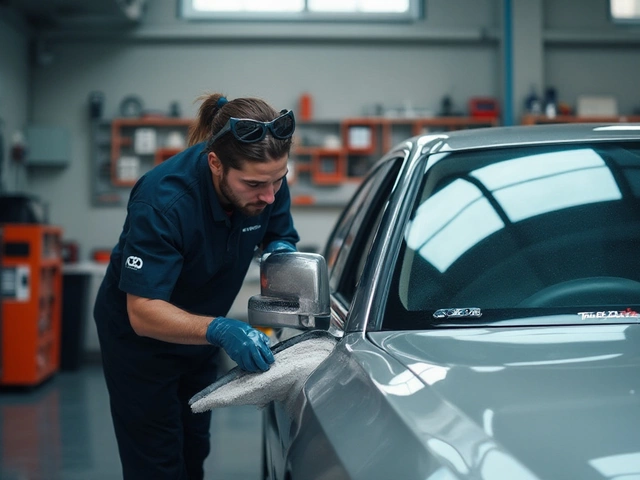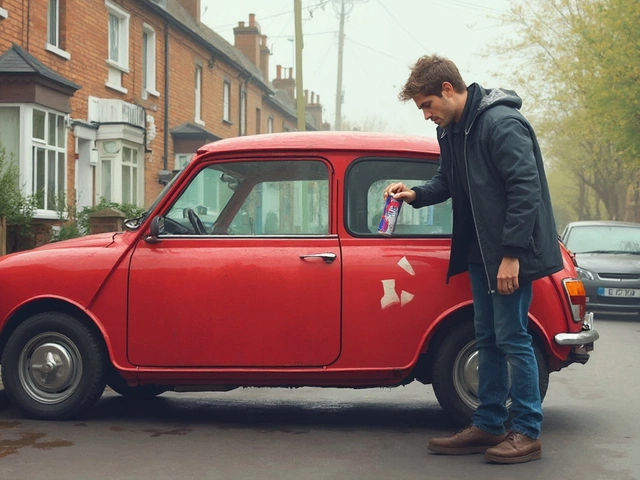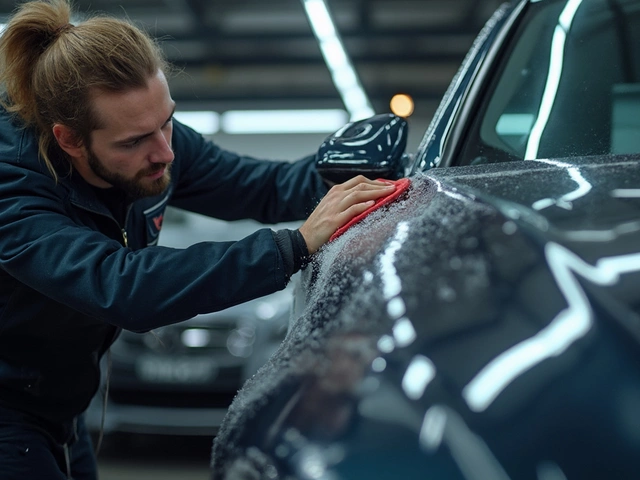An unused cup holder growing its own civilization. A mystery stain you’ve probably named. Swirls on your black paint that appeared overnight. You’ve noticed it, right? Cars age faster than we think. That fresh-off-the-lot shine doesn’t last unless you put in the work. Here’s the weird part: most people clean their car less often than they visit a dentist. Some only give it the royal treatment before selling it or after a spilled milk incident that turns their ride into a biohazard.
What 'Fully Detailing' a Car Actually Involves
Let’s be clear on what we mean by a "full detail." It’s not just a quick vacuum and a drive-through soap-and-slap. You’re talking about the works—exterior wash, clay bar treatment, paint decontamination, swirl removal, wax or sealant, deep wheel cleaning, undercarriage attention, and full-blown tire dressing. Inside, it means every surface cleaned or treated: shampoo carpets, steam-clean seats, protect dashboards, wipe every crevice, de-gunk the doors and cup holders, smash those window streaks, and more. Think of it as a spa day where your car walks out cleaner, shinier, and probably smelling less like old fries.
A professional detail, as done by reputable shops, takes three to eight hours and often involves specialized tools and high-grade products. If a shop offers a full detail in under two? That’s a red flag. Industry standards, like those from the International Detailing Association, suggest a true full detail covers all paint, glass, trim, metal, rubber, plastic, fabrics, and leather—plus areas you forgot cars even have.
Why get this extreme? Besides vanity, full detailing clears away more than cosmetic dirt. Contaminants like road salt, sap, bird droppings, and brake dust literally eat away at your paint and clear coat. Interior-wise, grime breaks down fabric and leather, while trapped moisture and crumbs breed bacteria and mold. You don’t want your car doubling as a science experiment, right?
How Often Should You Fully Detail Your Car?
Let’s rip the band-aid off: there’s no one-size-fits-all schedule. But you probably want a ballpark. Most detailing professionals and auto manufacturers (like Toyota and Honda) agree that two or three full details a year is the sweet spot for daily drivers—not garage queens or show cars.
Here’s why. Environmental exposure is the big villain. Live near the coast? Salt air will corrode everything faster. In the city? Acid rain and airborne grime do their share. Park under trees? Sap and bird bombs are relentless. Drive on gravel roads, or through winters with salted streets? That stuff eats cars alive. If you find yourself nodding, you might benefit from detailing as often as every three months.
But let’s talk about specific lifestyle cases:
- Urban commuters: 2-3 times per year. City filth, frequent parking, and lots of surface contact means you’ll pick up all sorts of gunk. Road salt alone can destroy a car under four years.
- Outdoor parkers: At least every 4-6 months. Sunlight, rain, pollen, sap, and endless dust will degrade paint and plastics.
- Families with kids or pets: Every 3-4 months. Spills, fur, crumbs—all that sits and seeps. Mold growth on seats can start after two weeks of staying damp!
- Long road-trippers: After every trip or quarterly. Bug splatters, tar, and interior grime add up fast.
- Weekend warriors/garage kept cars: Maybe every 10-12 months, unless you’re prepping for a show or event.
There’s real data behind this. According to a 2022 survey by the International Carwash Association, cars washed and detailed every three months retain about 8-10% more of their resale value over four years. Paint experts relate that UV degradation and neglect can reduce clear-coat life by 40% if untreated. And even more shocking? A dirty car is about twice as likely to have a mold or mildew issue in the A/C system than a regularly cleaned one. That means detailing isn’t a luxury, it’s a defense plan.
| Car Use & Location | Recommended Detailing Frequency | Key Risks If Ignored |
|---|---|---|
| Urban Daily Driver | 2-3x yearly | Paint scratches, rapid grime build-up, value loss |
| Highway Commuter | 2x yearly | Stone chips, bug acids, embedded dirt |
| Coastal/Salty Area | 3-4x yearly | Accelerated rusting, faded trim |
| Family Car (Kids/Pets) | 3-4x yearly | Stains, odors, germs, pests |
| Garage Queen | 1x year | Storage dust, inactivity residue |

Signs Your Car Needs a Full Detail
Noticing when things are out of control is easy. Smells that won’t leave, seats that feel sticky, steering wheel grime—even a foggy windshield inside are telltale signs it’s time. Car paint looking dull? Water doesn’t bead up anymore after a wash? That’s your wax gone and your protective shield is down. And if you run your hand over the paint and feel it’s rough instead of glassy, you’ve got contaminants stuck to the surface.
Other hints your car’s overdue:
- Persistent moldy, musty, or bad odors, even with the windows down.
- Allergies that get worse when you drive (dust and pollen trapped in vents and fabric can make things miserable).
- Foggy headlights and trim that look faded or patchy.
- Seats losing their original color or looking greasy.
- Sticky cupholders and fingerprints on touchscreens that just won’t come off with a wipe.
Here’s a practical tip: leave a small, smooth Ziplock bag in your glove box. Every once in a while, pull it over your hand and lightly rub the exterior paint. If it grabs and drags, your paint is dirty. If it slides smoothly, you’re golden.
Anybody selling or trading in a car should absolutely get a full detail. Dealers factor in the vehicle’s appearance into their trade-in or resale offer. It might cost $150-300, but can boost resale value by hundreds or even a couple of thousand. Especially since the first things buyers check are the smell, appearance of seats, console, and door pockets, followed by how fresh and glossy the paint looks.
And by the way: skip the scented trees or sprays masking odors. A pro detail removes odors at the source, including using tools like ozone generators or steam extractors that get into every fiber. Doing just a quick clean and skipping a true detail is like brushing teeth but never flossing—eventually, something’s going to smell bad.
Tips for Maintaining That Post-Detail Look
Getting your car fully detailed is one thing—keeping it looking that way is another beast. The trick? Put some simple habits in play so you don’t have to book a deep clean every month. First, avoid letting junk pile up. Make it a rule: nothing stays in the car that you didn’t bring in that trip. Second, run a damp microfiber cloth over the dash and screens once a week. Pop an old toothbrush in your glovebox for quick removal of dirt in vents and seams. Don’t underestimate the power of small routines.
Try this: every time you fill up with fuel, quickly shake out your mats (this works best with weatherproof rubber ones). Keeping mats clean traps most of the dirt before it spreads inside. For spills on fabric seats, blot immediately and use a basic upholstery cleaner—waiting even a day can make stains permanent.
Consider using a spray wax or quick detailer after a basic wash. These spray products take just a few minutes and boost shine, helping repel dust and light dirt until your next real detail. On the inside, use a simple fabric refresher or anti-static spray—these keep dust from clinging and help interiors stay neutral instead of turning musty.
If you go to DIY car washes, avoid the harsh brushes and choose the high-pressure rinse and foam gun instead. At home, use a two-bucket method—one for soapy water, one to rinse the mitt. This keeps grit from scratching your paint. Skip the cheap sponges; microfiber mitts are less than $10 and won’t leave swirl marks.
Keeping your windows streak-free is trickier than it looks. Always dry windows with a separate clean microfiber towel. Some people add a drop of vinegar to warm water to tackle stubborn residue—just don’t use paper towels, which can leave fuzzy bits and scratches behind.
When it comes to maintenance products, check out user forums, too. Real-world reviews on brands like Chemical Guys, Meguiar’s, and Griot’s Garage will tell you which ones actually make a difference. Some waxes last just weeks, while polymer sealants can give you a solid six months of paint protection with minimal effort.
Lastly, set calendar reminders for the next full detail—you’re already paying for oil changes, so why not care for your car’s look, too? Treating your ride right isn’t just about pride; it’s about protection and squeezing the most value out of your car, day after day.




